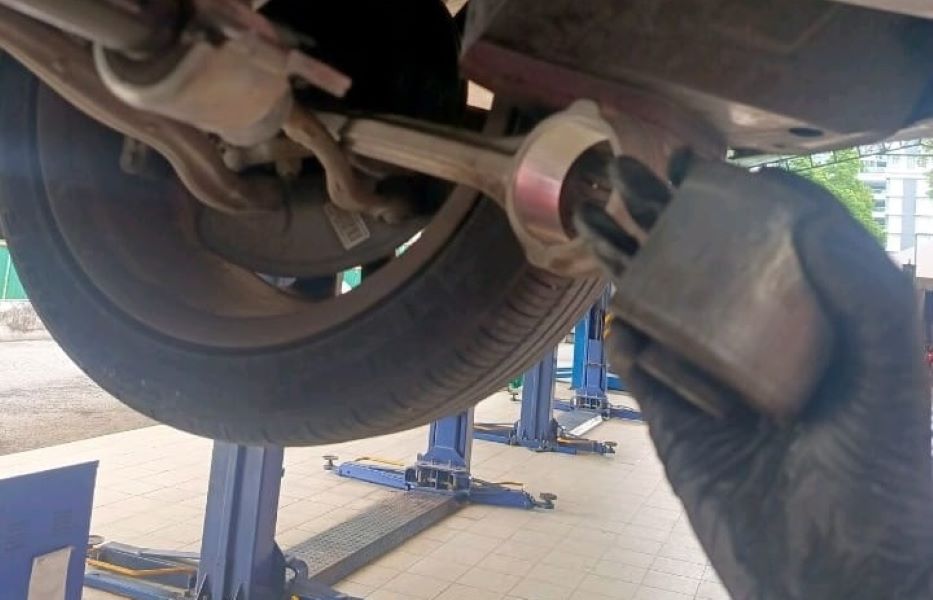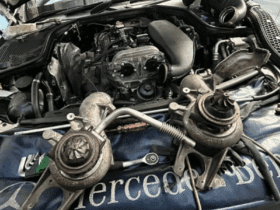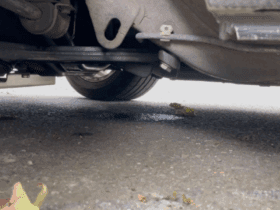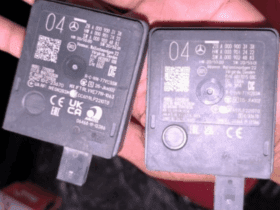Table of Contents
While Driving Front Area Got Sound: Mercedes-Benz C180 OM626 Case Study
Hearing unusual noises from your car’s front suspension is never a good sign. For many drivers, the complaint often comes as: “While driving, front area got sound.” This was exactly the case with a Mercedes-Benz C Class 180 equipped with the OM626 engine that arrived in our workshop.
The driver reported a persistent clunking noise from the front end, most noticeable when turning or driving over uneven roads. Left unchecked, these noises can lead to unsafe driving conditions, higher repair costs, and reduced comfort.
In this case study, we’ll explore the diagnosis, repair process, and final resolution plus practical tips and FAQs to help owners better understand front suspension noise in Mercedes vehicles.
Step 1: Initial Inspection : Tracing the Source of Noise
When diagnosing a “While driving front area got sound” complaint, technicians typically begin with a comprehensive suspension and steering check. The usual culprits include:
- – Lower control arm bushings : absorb road shocks and keep suspension aligned.
- – Stabilizer (anti-roll) bar links : stabilize the vehicle during cornering.
- – Ball joints and tie rods : connect the suspension to steering and allow controlled wheel movement.
- – Shock absorbers and mounts : manage vertical motion and prevent bouncing.
In the Mercedes C180’s case:
- – The lower control arm bushings were worn and cracked.
- – The stabilizer bar links showed play and damaged rubber boots.
Both faults aligned with the driver’s complaint of clunking noises during motion and turning.
Step 2: Repair Process : Restoring Suspension Performance
Once the worn components were identified, the repair process was straightforward but required precision.
1. Removing Damaged Bushings and Links
- – The lower control arm bushings and stabilizer links were carefully removed.
- – Extra care was taken to avoid damaging adjacent components.


2. Installing OEM-Grade Parts
- – New Mercedes-approved bushings and stabilizer links were fitted.
- – Using OEM-quality parts ensures longer durability and consistent handling.


3. Torque Specifications Check
- – All bolts and fasteners were tightened according to Mercedes-Benz specifications.
- – Correct torque is critical to prevent premature wear or additional noise.
4. Road Test Confirmation
- – After reassembly, the vehicle was test-driven over bumps and during cornering.
- – Result: The suspension noise was completely eliminated.
Step 3: Why This Fix Matters
Many drivers ignore suspension noises, thinking they are harmless. But in reality, they can cause:
- – Poor Handling: Worn suspension parts affect vehicle stability and steering response.
- – Accelerated Tire Wear: Misaligned or unstable suspension components lead to uneven tire wear.
- – Safety Risks: Suspension faults increase stopping distances and compromise control in emergency situations.
By replacing worn bushings and stabilizer links, this Mercedes C180 regained its quiet ride, stable handling, and factory-level safety.
Pro Tips: Spotting Worn Suspension Components
If you hear similar noises from your car’s front end, look out for these signs:
- – Visual cracks or wear on control arm bushings.
- – Free movement in stabilizer links when pushed by hand.
- – Unusual tire wear patterns caused by suspension misalignment.
- – Metal-on-metal noise when driving over bumps.
A simple pry bar test during inspection can also reveal looseness in joints and bushings.
Symptom –> Cause –> Fix Table
| Symptom | Likely Cause | Repair Solution |
|---|---|---|
| Clunking over bumps | Worn lower control arm bushings | Replace bushings with OEM-grade parts |
| Rattling during cornering | Damaged stabilizer bar links | Replace stabilizer links and bushings |
| Uneven tire wear | Suspension misalignment due to worn arms | Replace bushings and perform alignment |
| Poor steering response | Loose ball joints or tie rods | Inspect and replace faulty joints |
| Continuous knocking sound | Failing shock mounts | Replace mounts and inspect shocks |
Explore More Mercedes Suspension Issues
For a deeper dive into suspension problems such as uneven ride height, AIRMATIC malfunctions, “Stop Vehicle Too Low” warnings, and vibration faults, visit our hub: Mercedes-Benz Suspension Issues – Symptoms, Causes & Fixes. There you’ll find grouped case studies, step-by-step diagnostics, symptom, cause, fix tables, and preventive tips to keep your Mercedes riding smoothly.
What Does a Bad Front Suspension Sound Like?
A failing front suspension usually produces:
- – Clunking or knocking sounds over bumps.
- – Popping noises while steering.
- – Creaking or rattling during slow turns.
In this Mercedes C180 case, the clunking was most noticeable at low speeds on uneven surfaces, which is a classic indicator of worn bushings and stabilizer links.
FAQs: While Driving Front Area Got Sound
Q: Is it safe to drive with front suspension noise?
A: While the car may still move, it’s not safe long-term. Worn suspension parts reduce handling precision, increase braking distances, and may cause further damage if ignored.
Q: How much does it cost to fix front suspension noise in a Mercedes C180?
A: Costs vary by location, but typical repairs include:
- – Control arm bushings: $400–$600
- – Stabilizer bar links: $200–$350
- – Full suspension service with alignment: $800–$1,200
Q: Can suspension noise return after repairs?
A: If all faulty parts are replaced with OEM components and installed correctly, the noise should not return. However, ignoring related parts (like mounts or tie rods) may allow new noises to develop.
Q: How can I prevent suspension problems?
A:
- – Inspect suspension every 20,000–30,000 miles.
- – Replace worn boots and bushings early.
- – Avoid potholes and rough driving conditions.
- – Use OEM or high-quality aftermarket parts.
Conclusion
The “While driving front area got sound” issue in this Mercedes-Benz C180 OM626 was traced to worn lower control arm bushings and stabilizer bar links. Through precise diagnostics, OEM-grade replacements, and proper torque checks, the suspension noise was eliminated, restoring the car’s smooth, quiet, and safe ride.
This case study highlights the importance of listening to your vehicle. Suspension noises are not just annoyances they are warning signs of wear, misalignment, or damage. By addressing them early, you not only restore comfort but also ensure long-term safety and prevent more expensive repairs.
Author
Written by Mercedes Expert
With years of hands-on experience diagnosing and repairing Mercedes-Benz systems, he brings technical depth and practical case studies to help car owners, technicians, and enthusiasts troubleshoot complex automotive issues. His work focuses on clear repair guides, OEM-level procedures, and knowledge-sharing to empower both professionals and drivers.
Last Updated: September 2025
— Salim, Mercedes Expert
Independent specialist in Mercedes-Benz diagnostics, CAN Bus analysis, troubleshooting case studies, and EV systems.







Leave a Reply